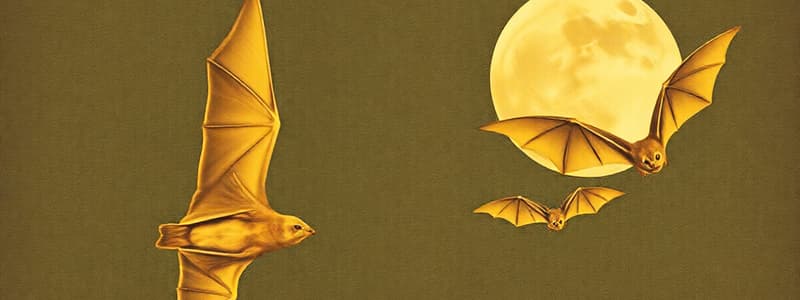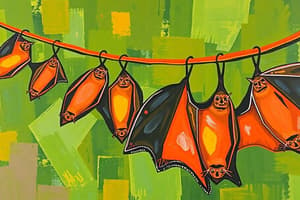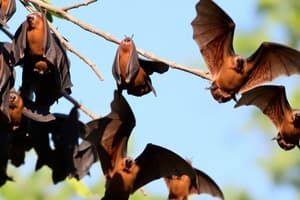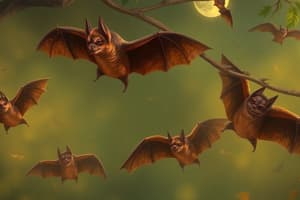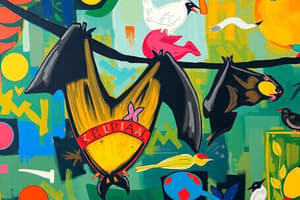Podcast
Questions and Answers
Given that the fruit bats consume over a billion fruits in a month, what can we conclude about the ecosystem?
Given that the fruit bats consume over a billion fruits in a month, what can we conclude about the ecosystem?
- The ecosystem relies heavily on the fruit bats for seed dispersal, making them crucial to its biodiversity. (correct)
- The ecosystem is highly resilient and can withstand the large consumption of fruits by the bats.
- The ecosystem is likely imbalanced due to the large populations of fruit bats.
- The ecosystem is likely to suffer from significant fruit depletion during the bats' month-long stay.
Which of the following adaptations is MOST likely NOT a factor in the fruit bats' ability to navigate during migration?
Which of the following adaptations is MOST likely NOT a factor in the fruit bats' ability to navigate during migration?
- Their keen sense of smell to detect ripe fruit.
- Their use of echolocation to map surroundings. (correct)
- Their exceptional capacity for memorizing landmarks.
- Their large eyes with strong night vision.
The content suggests that the fruit bat roosting area is located in a specific type of forest. What type of forest is it most likely to be?
The content suggests that the fruit bat roosting area is located in a specific type of forest. What type of forest is it most likely to be?
- Tropical rainforest. (correct)
- Deciduous forest.
- Taiga.
- Temperate coniferous forest.
Based on the information provided, estimate the approximate number of fruit bats in this area during the day in comparison to the number during the night?
Based on the information provided, estimate the approximate number of fruit bats in this area during the day in comparison to the number during the night?
Which of these statements BEST explains the benefit of the fruit bats to the ecosystem?
Which of these statements BEST explains the benefit of the fruit bats to the ecosystem?
Flashcards
Straw-Coloured Fruit Bats
Straw-Coloured Fruit Bats
A large gathering of bats, numbering ten million, residing in a swamp area.
Largest Mammal Migration
Largest Mammal Migration
The migration of straw-coloured fruit bats, considered the largest in number on Earth.
Wing Structure
Wing Structure
Fruit bats have wings made of skin membranes reinforced with muscles for control.
Feeding Habits
Feeding Habits
Signup and view all the flashcards
Seed Dispersal Role
Seed Dispersal Role
Signup and view all the flashcards
Study Notes
Fruit Bat Migration
- A gathering of ten million straw-coloured fruit bats inhabit a swamp spanning half a square mile.
- This concentration is among the largest known fruit bat gatherings globally.
- It's considered the largest mammal migration on Earth by sheer numbers.
- The bats roost in a specific patch of moist evergreen forest during the day.
- While roosting, they use a hook on their wingtip to grip and climb for suitable spaces.
- Fruit bats are nicknamed "flying foxes" due to their gingery bodies and pointed faces.
- Each bat measures approximately eight inches in length and has a wingspan of two and a half feet.
- Their wings consist of a membrane of skin, supported by a network of thin muscles controlling wing shape and rigidity.
- Fruit bats do not use echolocation; instead, they rely on their vision.
- Their large eyes are visible at night due to eye shine.
- They locate their fruit-based food using sight and smell.
- Their favourite food is waterberries.
- Each bat consumes five pounds of fruit nightly, double its body weight.
- During their month-long stay, over a billion fruits are consumed, completely depleting the trees.
- Despite consuming a substantial amount of fruit, fruit bats are beneficial rather than harmful.
- Fruit bats are responsible for 60% of seed dispersal in the area, aiding forest regeneration.
- Their seed dispersal ensures a continuous supply of fruit.
Studying That Suits You
Use AI to generate personalized quizzes and flashcards to suit your learning preferences.
